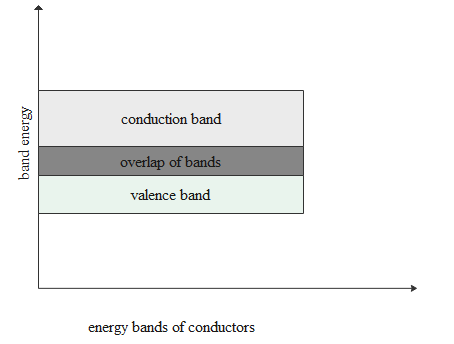
The resistance of a metallic conductor increases with temperature due to:
A. change in carrier density
B. change in the dimensions of the conductor
C. increase in the number of collisions among the carriers
D. increase in the rate of collisions between the carriers and the vibrating atoms of the conductor.
Answer
540k+ views
Hint: Whenever we speak about conductivity of a substance let it be an insulator or conductor or semiconductor we consider energy levels of charge carriers. In case of semiconductors there are two bands one is valence band and the other is conduction band. The energy variation between lower valence band and upper conduction band is called the forbidden energy gap of a semiconductor. In between this energy gap no electron will be there in case of intrinsic semiconductor. Now with increase in temperature thermal energy of an electron in valence band increases and reaches the conduction band and this charge carrier conducts electricity. But in the case of conductors, charge carriers which conduct electricity already exist. Something different happens in case of conductors due to temperature increase.
Complete answer:
When temperature of the conductor is increased both atoms and free electrons gain thermal energy and start vibrating vigorously with higher amplitudes.

Forbidden energy gaps in semiconductors would be nearly 1ev.

In case of conductors both conduction and valence bands get overlapped. Number of collisions increases and the rate at which collisions occur will also get enhanced. When this rate gets increased it becomes obstruction to flow of electrons in that conductor. This slows down electron flow which means current flow is decreased because current is nothing but rate of flow of free charge carriers. Current flow reduced means resistance is increased
Hence the answer would be D.
Note:
In case of semiconductors also the rate of collisions increases due to temperature rise and relaxation time(time consumed between two successive collisions) gets decreased. But this factor will be overcome by the huge amount of creation of conducting charge carriers and hence its resistance decreases with increase in temperature. So change in carrier density plays a key role in varying resistance of a semiconductor rather than a conductor.
Complete answer:
When temperature of the conductor is increased both atoms and free electrons gain thermal energy and start vibrating vigorously with higher amplitudes.

Forbidden energy gaps in semiconductors would be nearly 1ev.

In case of conductors both conduction and valence bands get overlapped. Number of collisions increases and the rate at which collisions occur will also get enhanced. When this rate gets increased it becomes obstruction to flow of electrons in that conductor. This slows down electron flow which means current flow is decreased because current is nothing but rate of flow of free charge carriers. Current flow reduced means resistance is increased
Hence the answer would be D.
Note:
In case of semiconductors also the rate of collisions increases due to temperature rise and relaxation time(time consumed between two successive collisions) gets decreased. But this factor will be overcome by the huge amount of creation of conducting charge carriers and hence its resistance decreases with increase in temperature. So change in carrier density plays a key role in varying resistance of a semiconductor rather than a conductor.
Recently Updated Pages
Master Class 12 Business Studies: Engaging Questions & Answers for Success

Master Class 12 Economics: Engaging Questions & Answers for Success

Master Class 12 English: Engaging Questions & Answers for Success

Master Class 12 Maths: Engaging Questions & Answers for Success

Master Class 12 Social Science: Engaging Questions & Answers for Success

Master Class 12 Chemistry: Engaging Questions & Answers for Success

Trending doubts
What are the major means of transport Explain each class 12 social science CBSE

Which are the Top 10 Largest Countries of the World?

Draw a labelled sketch of the human eye class 12 physics CBSE

Explain sex determination in humans with line diag class 12 biology CBSE

The pH of the pancreatic juice is A 64 B 86 C 120 D class 12 biology CBSE

Explain sex determination in humans with the help of class 12 biology CBSE




